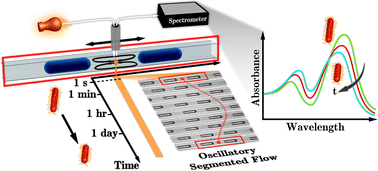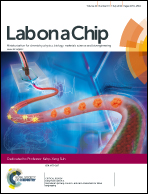Shaken, and stirred: oscillatory segmented flow for controlled size-evolution of colloidal nanomaterials†
Abstract
We introduce oscillatory segmented flow as a compact microfluidic format that accommodates slow chemical reactions for the solution-phase processing of colloidal nanomaterials. The strategy allows the reaction progress to be monitored at a dynamic range of up to 80 decibels (i.e., residence times of up to one day, equivalent to 720–14 400 times the mixing time) from only one sensing location. A train of alternating gas bubbles and liquid reaction compartments (segmented flow) was initially formed, stopped and then subjected to a consistent back-and-forth motion. The oscillatory segmented flow was obtained by periodically manipulating the pressures at the device inlet and outlet via square wave signals generated by non-wetted solenoid valves. The readily implementable format significantly reduced the device footprint as compared with continuous segmented flow. We investigated mixing enhancement for varying liquid segment lengths, oscillation amplitudes and oscillation frequencies. The etching of gold nanorods served as a case study to illustrate the utility of the approach for dynamic characterization and precise control of colloidal nanomaterial size and shape for 5 h. Oscillatory segmented flows will be beneficial for a broad range of lab-on-a-chip applications that require long processing times.


 Please wait while we load your content...
Please wait while we load your content...